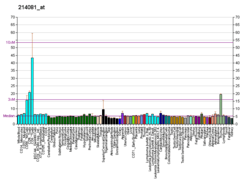Plexin domain-containing protein 1 is a protein that in humans is encoded by the PLXDC1 gene.[5][6][7]
References
- 1 2 3 GRCh38: Ensembl release 89: ENSG00000161381 - Ensembl, May 2017
- 1 2 3 GRCm38: Ensembl release 89: ENSMUSG00000017417 - Ensembl, May 2017
- ↑ "Human PubMed Reference:".
- ↑ "Mouse PubMed Reference:".
- ↑ St Croix B, Rago C, Velculescu V, Traverso G, Romans KE, Montgomery E, Lal A, Riggins GJ, Lengauer C, Vogelstein B, Kinzler KW (Aug 2000). "Genes expressed in human tumor endothelium". Science. 289 (5482): 1197–202. doi:10.1126/science.289.5482.1197. PMID 10947988.
- ↑ Carson-Walter EB, Watkins DN, Nanda A, Vogelstein B, Kinzler KW, St Croix B (Sep 2001). "Cell surface tumor endothelial markers are conserved in mice and humans". Cancer Res. 61 (18): 6649–55. PMID 11559528.
- ↑ "Entrez Gene: PLXDC1 plexin domain containing 1".
Further reading
- Fuchs B, Mahlum E, Halder C, et al. (2007). "High expression of tumor endothelial marker 7 is associated with metastasis and poor survival of patients with osteogenic sarcoma". Gene. 399 (2): 137–43. doi:10.1016/j.gene.2007.05.003. PMC 2066185. PMID 17560052.
- Nanda A, Buckhaults P, Seaman S, et al. (2005). "Identification of a binding partner for the endothelial cell surface proteins TEM7 and TEM7R". Cancer Res. 64 (23): 8507–11. doi:10.1158/0008-5472.CAN-04-2716. PMID 15574754.
- Gerhard DS, Wagner L, Feingold EA, et al. (2004). "The status, quality, and expansion of the NIH full-length cDNA project: the Mammalian Gene Collection (MGC)". Genome Res. 14 (10B): 2121–7. doi:10.1101/gr.2596504. PMC 528928. PMID 15489334.
- Ota T, Suzuki Y, Nishikawa T, et al. (2004). "Complete sequencing and characterization of 21,243 full-length human cDNAs". Nat. Genet. 36 (1): 40–5. doi:10.1038/ng1285. PMID 14702039.
- Strausberg RL, Feingold EA, Grouse LH, et al. (2003). "Generation and initial analysis of more than 15,000 full-length human and mouse cDNA sequences". Proc. Natl. Acad. Sci. U.S.A. 99 (26): 16899–903. doi:10.1073/pnas.242603899. PMC 139241. PMID 12477932.
- Yu W, Andersson B, Worley KC, et al. (1997). "Large-scale concatenation cDNA sequencing". Genome Res. 7 (4): 353–8. doi:10.1101/gr.7.4.353. PMC 139146. PMID 9110174.
- Andersson B, Wentland MA, Ricafrente JY, et al. (1996). "A "double adaptor" method for improved shotgun library construction". Anal. Biochem. 236 (1): 107–13. doi:10.1006/abio.1996.0138. PMID 8619474.





